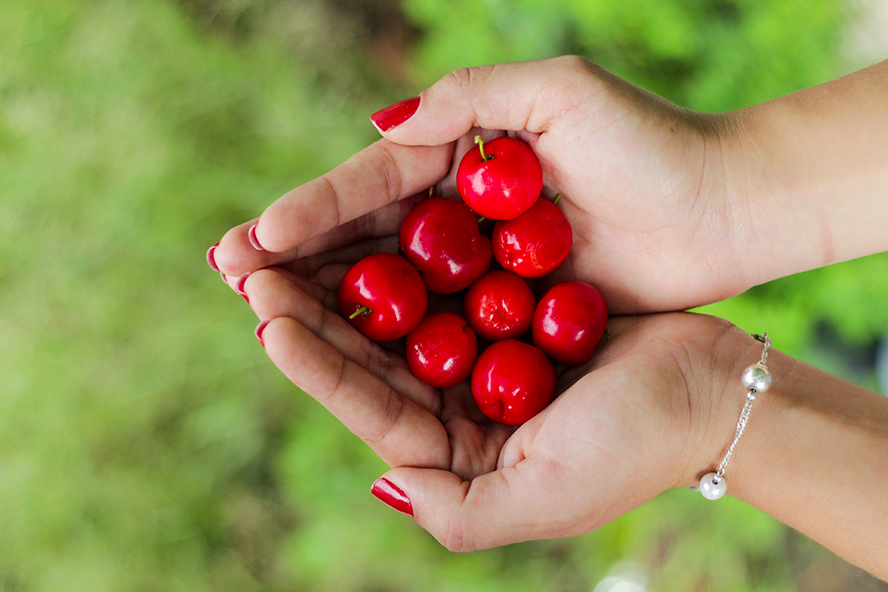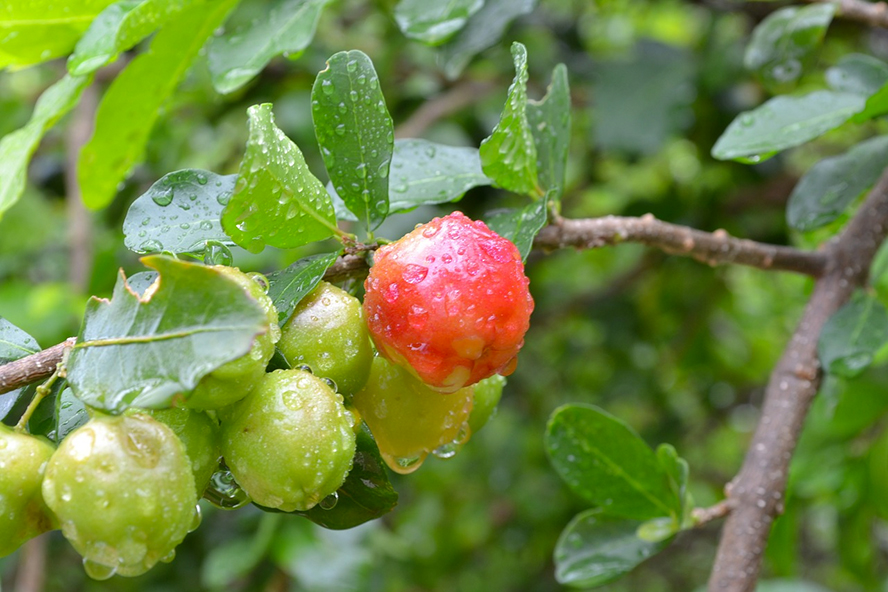Getting to Know Acerola Cherry

Maybe you’ve noticed a new kind of cherry showing up in your super food blends and vitamin aisles? Don’t be shy! She’s friendly, and as it turns out… is quite handy when you aren’t feeling so well.
Meet: Malpighia glabra, or‘Acerola Cherry’ for short. She’s also been known to go by ‘Barbados Cherry’ or ‘West Indian Cherry,’ depending on who she’s talking to.
Lately, the spotlight has been turned to Acerola for her vitamin C prowess. With the globe being encircled by a viral pandemic, the need and desire for self preservation in the form of immune system boosting has led formulators to scour for potent, high-dose, and sustainable sources of Vitamin C. Acerola’s got you there. She’s got more vitamin C than oranges or lemon - 50-125x more. Seriously.
The extremely-large amount of vitamin C in this cherry-like fruit lends to a sour, “tart” flavor. As Acerola’s fruit ripens, it begins to lose a great deal of this vitamin content - for this reason, most commercial acerola is harvested in the tropics while it is still green.

Traditional and Tribal Knowledge:
Once again, there’s nothing new to see here. Acerola has been a beloved fruit by indigenous and local peoples throughout South and Latin America and the Caribbean. Acerola cherry juice is as common in Brazil as orange juice is in the US.
Traditionally used for treatment of fever and dysentery, she has also been known for use as an anti-inflammatory, liver and renal system stimulant, and to support heart function. Before Camu Camu was well studied, Acerola was considered the highest concentration of vitamin C in any fruit.
More than Vitamin C Alone: Form leads to Function
Don’t sell it short, Acerola brings more to the table than just tons of vitamin C, and indigenous elders knew this. There are some things that you cannot create in a lab; health and wellness tends to be one of them. This brings me to the point of differentiating between a whole plant/food source of nutrients versus that of a synthetic analog.
Let’s take Acerola as a whole, for instance. There are over 150 active constituents identified in the fruit. If we were to compare “Cherries to Oranges”, Acerola has double the amount of magnesium, vitamin K, and Vitamin B5 (aka pantothenic acid) as oranges. (Note: All animals require pantothenic acid in order to synthesize Co-Enzyme A – essential for fatty acid metabolism – as well as to, in general, synthesize and metabolize proteins, carbohydrates, and fats.) Vitamin A, thiamine, riboflavin, and niacin also fill out the line-up of important nutrients held within this cherry.
Most Vitamin C supplements on the market are synthetic forms of vitamin C. Only a few companies sell true vitamin C that comes from berries. Camu Camu, Rose Hips, and Acerola cherries are some of the few food sources that naturally contain very high amounts of naturally occurring vitamin C. Synthetic vitamin C in the form of ascorbic acid can over time tax your organs, as much of it gets eliminated through the kidneys.
Most vitamin C and multivitamin supplements contain ascorbic acid or ascorbate, which is the outer ring that surrounds the real vitamin C complex. Real vitamin C is a complex of several different factors, all of which must work together to get Vitamin C’s health benefits.
Whole food vitamin C is ascorbic acid “grown” naturally into a food, which creates a final product that provides all of the cofactors needed for the body to fully assimilate the nutrients. Similarly, food-based vitamins include a food complex that may consist of fruit and vegetable concentrates combined with ascorbic acid. Proponents say they enhance digestion and absorption of the vitamin C compared to isolated ascorbic acid.

Radiance of the Tropics:
As you use Acerola Cherry regularly, you will notice a‘glow-up’ effect. Due to its high vitamin C content, the cherry subsequently is endowed with super antioxidant capabilities, neutralizing free-radicals and reducing oxidative damage to cells. For this reason Acerola appears in anti-aging skin formulas across the market. Once again, don’t sell it short, it’s not just about the vitamin C alone - acerola also revitalizes tired, stressed skin via the mineral salts contained in the fruit. Those secondary and tertiary active components in the fruit help nourish aged, lack-luster skin. Mucilage and protein from the fruit contain skin-hydrating properties and promote capillary conditioning.
Where Can You Get Fresh Acerola Cherries?
Unfortunately, unless you live in South America, it is very hard to get fresh acerola cherries as mentioned earlier. They ripen and spoil very quickly after being picked. If you want to consume fresh acerola cherries, you only have about 5 days from when they are picked before they begin to spoil.
In addition, as the Acerola ripens, the Vitamin C content decreases. So, if you were able to find ripened Acerola Cherries, they would have lower Vitamin C than unripped Acerola.
So, how can we get unripened, nutrient dense, bursting with Vitamin C Acerola Cherries here in the US?
By purchasing 100% USDA Organic Perfect Acerola Powder. Made with just one ingredient - unripened Acerola Cherries - and freeze-dried to lock in all the nutrients.
Click here to learn more about the Perfect Acerola Powder.











